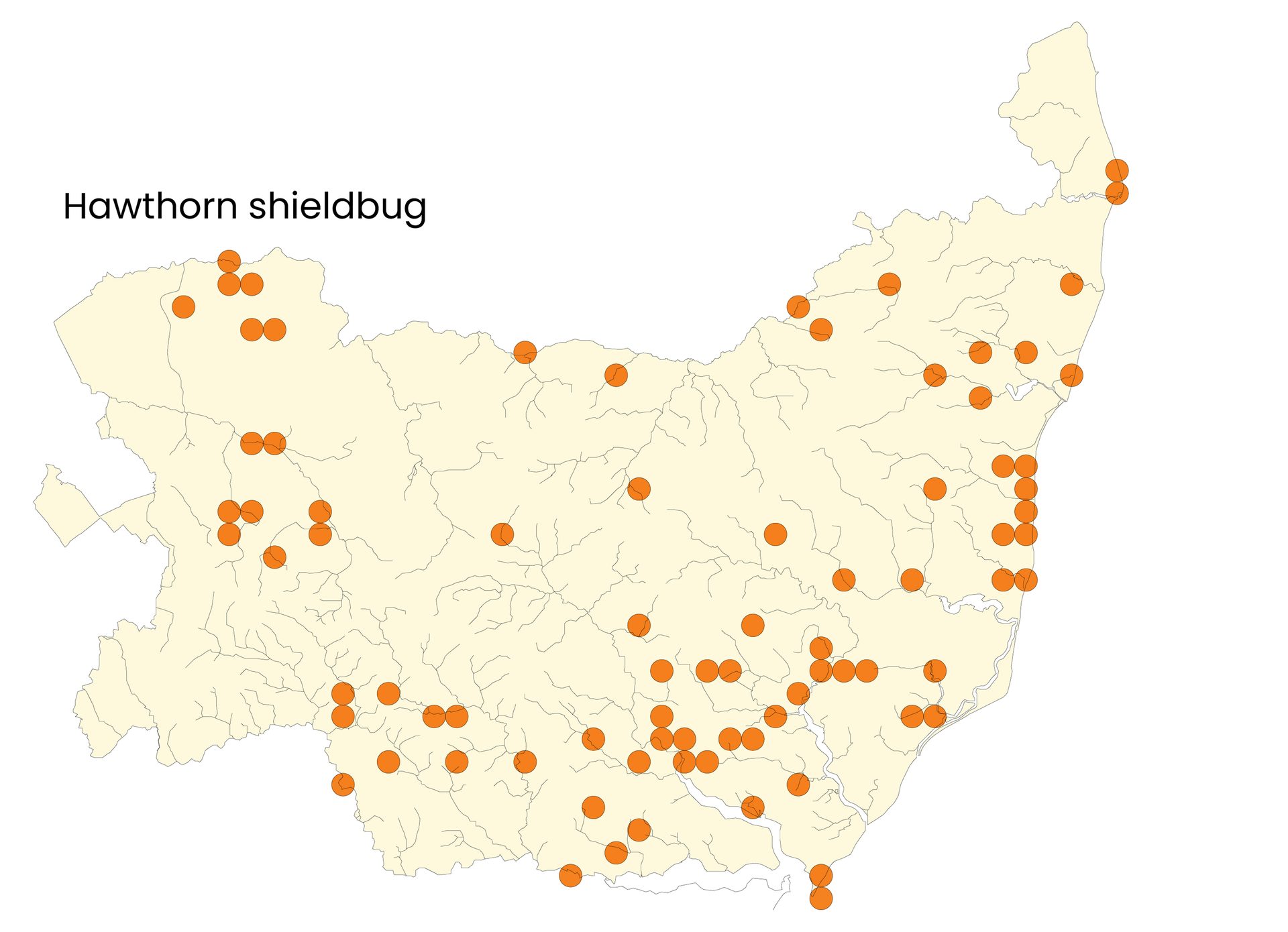Hawthorn Shieldbugs are the largest and most commonly spotted shieldbug in the UK.
Etymology
Their Latin and common names describe them perfectly: Acanthosoma haemorrhoidale – acantho means thorn, soma means body, and haemorrhoida means bleeding. So, a bug with a thorn-like body and a red pattern resembling bleeding. Hawthorn Shieldbug – their preferred food is Hawthorn, and they have a body shaped like a knight’s shield.
Hawthorn Shieldbugs are the largest UK shieldbugs, with a wingspan of 1.6cm and a length of 13–15mm. The adults have relatively broad, flat bodies that taper to the rear, giving them a distinctive shield shape.
They have short pointed spikes on their ‘shoulders’ (lateral extensions of the pronotum) and red-brown wings. The tip of their abdomen is often red, as are their eyes and their antennae have five segments.
Visit britishbugs.org.uk for a guide to anatomy.
Description


© Peter Stenzel, Flickr
© Paul Kitchener, Flickr
They are usually bright green with black speckles and orange-brown markings on the base of the pronotum and inner margins of the wings.
In the autumn, they can lose their green colouration and become reddish brown with black speckles as they prepare to hibernate. This makes their body’s structural details a more reliable identification tool than their colouring.
© Nutmeg 66, Flickr
For more information on identification visit britishbugs.org.uk and Shieldbug ID at the Woodland Trust.
Field Studies Council have worked with the Royal Entomological Society to create the fold-out guide Shieldbugs of the British Isles


Hawthorn Shieldbugs are abundant across the UK and commonly found in woodland, parks, and gardens.
To find them look at shrubby plants and trees, for example, Hawthorn, Hazel, Rowan, Birch, and Oak, rather than shorter vegetation.
Distribution in Suffolk
Lifecycle
Hawthorn Shieldbugs live around two years.
A 2013 study found that female shieldbugs lay their eggs in the daytime, after feeding on host plants with fruit. The 2-28 whitish eggs are laid in several batches. Unlike some other shieldbugs, Hawthorn Shieldbugs don’t stay to look after their eggs or nymphs; they are left to fend for themselves.
© Tim Worfolk, Flickr
After hatching, the nymphs develop through five instar stages before adulthood. The renowned ecologist, Alan Watson Featherstone, explains, “Because they have hard exoskeletons, insects such as shieldbugs cannot grow continuously like mammals or birds. Instead, they have distinct stages of growth called instars. They moult from one instar to the next by bursting out of the outgrown exoskeleton, leaving it behind as a cast skin known as an exuvia.”
British Bugs has an excellent illustration of Shieldbug life stages.
5th instar
4th instar
2nd instar
1st instar
Images: Newly hatched nymphs: Tim Haye, Flickr; 2nd stage instar Darius Baužys, Flickr; 4th stage instar Margaret Holland, Flickr; 5th instar Paul Kitchener, Flickr.
The translucent, white first instar nymphs often stay clustered together, presumably for protection. Although most Hawthorn Shieldbug nymphs are green, red variations can be found. In late instars, you can see where their wings are developing on the thorax. The nymphs mature in August and will be found close to their food plants.
Adult shieldbugs hibernate in crevices in trees and at the base of grassy tussocks.
© Paul kitchener, Flickr
Did you know?
Hawthorn shield bugs are drawn to bright lights and can often turn up in moth traps.
Diet
Hawthorn Shieldbug nymphs feed on ripening haws, the fruit of the hawthorn tree, by injecting saliva enzymes into plant tissue to partially digest it and then suck up the resulting liquid. They also eat rowan and whitebeam berries.
When no fruit is available, adults feed on the leaves of Hawthorn, pedunculate oak, sessile oak, and whitebeam.
© Allan Hopkins, Flickr
© Bob Knigh, Flickr
Did you know?
They are sometimes called stink bugs as they release a pungent orange fluid when stressed.
Spotting them
When to see them: April to October.
Please help us to monitor changes in our local population by recording your sightings.
© Paul Kitchener, Flickr
Created by: Suffolk Biodiversity Information Service
* Jana Hanelová & Jitka Vilímová, Behaviour of the central European Acanthosomatidae (Hemiptera: Heteroptera: Pentatomoidea) during oviposition and parental care, Acta Musei Moraviae, Sci. biol. (Brno), 98(2), 2013. ^ RETURN to text

